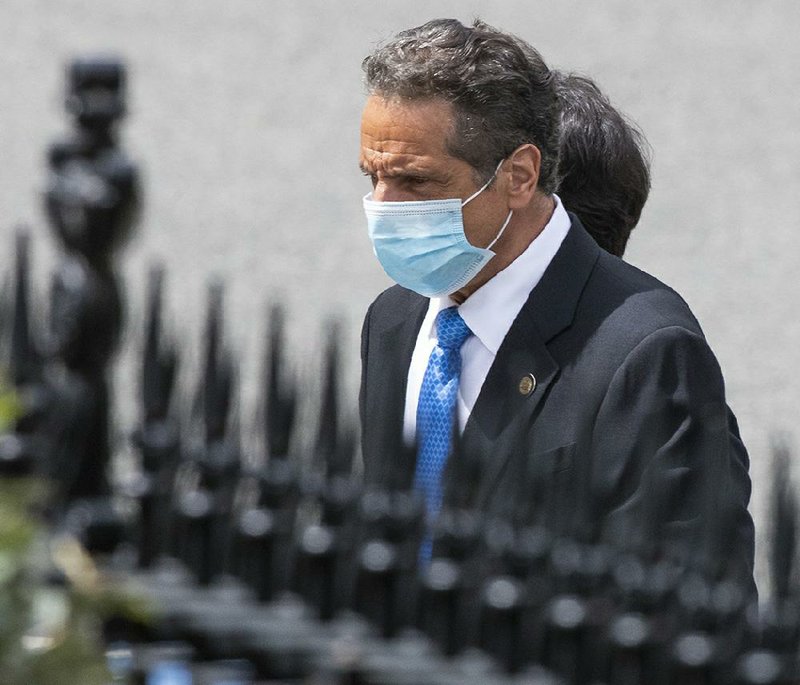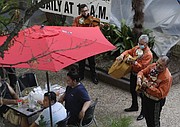HARTFORD, Conn. -- The U.S. surpassed a milestone Wednesday in the coronavirus pandemic -- 100,000 deaths, according to a tally by Johns Hopkins University.
"It's a striking reminder of how dangerous this virus can be," said Josh Michaud, associate director of global health policy with the Kaiser Family Foundation in Washington.
Worldwide, the virus has infected more than 5.68 million people and killed more than 354,000, with the U.S. having the most confirmed cases and deaths. Europe has recorded about 170,000 deaths.
The true death toll from the virus, which emerged in China late last year and was first reported in the U.S. in January, is widely believed to be significantly higher, with experts saying many victims died of covid-19 without ever being tested for it.
Comparing countries is tricky, given varying levels of testing and the fact that some coronavirus deaths can be missed. According to figures tracked by Johns Hopkins University, the death rate per 100,000 people is lower in the U.S. than Italy, France and Spain but higher than Germany, China, South Korea, Singapore, Japan, New Zealand and Australia.
[CORONAVIRUS: Click here for our complete coverage » arkansasonline.com/coronavirus]
"The experience of other countries shows that death at that scale was preventable," Michaud said. "To some extent the United States suffers from having a slow start and inconsistent approach. We might have seen a different trajectory if different policies were put into place earlier and more forcefully."
Countries with low death rates suppressed the virus "through lots of testing, contact tracing and policies to support isolation and quarantine of people at risk," Michaud said.
The virus exacted an especially vicious toll on New York City and its surrounding suburbs, killing more than 21,000. At the peak, hundreds of people were dying each day in New York City.
The densely packed New York metropolitan area, having about 20 million people across a region that encompasses the city's northern suburbs, Long Island and northern New Jersey, has been the hardest-hit corner of the country.
New York Gov. Andrew Cuomo on Wednesday used a White House meeting to pitch Trump on a huge investment in train lines, bridges and other building projects as a way to "supercharge" an economy laid low by the novel coronavirus.
Cuomo emerged from the meeting proclaiming that the president "gets it," saying that he and Trump talked as New Yorkers and that he appealed to Trump's instincts as a builder.
There is no vaccine or treatment for covid-19, though several emergency treatments are being used after showing some promise in preliminary testing.
Worldwide, about a dozen vaccine candidates are starting to be tested or getting close to it. Health officials have said studies of a potential vaccine might be done by late this year or early next year.
A DAUGHTER SPEAKS
Among the 100,000 U.S. deaths was 74-year-old Michael Ganci, a resident of Newington, Conn., who died March 21. He was a public school teacher, a grandfather and father of four, and a fourth-degree belt sensei in kyokushin karate.
Ganci, who had a compromised immune system, died at St. Francis Hospital in Hartford, Conn., three days after showing symptoms. His family was not allowed to be with him and tried to text and talk with him on his cellphone during his final days. His wife of 48 years also tested positive for the virus and was forced to grieve alone.
For their daughter, Joanna Ganci, 45, of Beverly, Mass., the milestone and other statistics are important to understand the scope of the virus.
"But at the same time, I think the danger of counting, the danger of statistics, is that it just minimizes the human element," she said. "And I think, again, we see that our country is in the throes of this kind of moment of just that the numbers don't seem to mean anything anyway to many. It's like, what number is going to make an impact for people who haven't been touched by it?"
"For people whose lives haven't been threatened or where the virus hasn't been as rampant through a community, I just think numbers or not, it's still so abstract to so many people," she said. "It doesn't matter if it's 200,000, 100,000 or 10. It doesn't mean anything until you're personally affected by it."
[Video not showing up above? Click here to watch » https://www.youtube.com/watch?v=KCe8dL-IZnA]
Americans have responded to the coronavirus pandemic with outpourings of gratitude -- New Yorkers' nightly chorus of cheers for health care workers, for example -- and widespread cooperation, including extraordinary, quick pivots to staying at home and wearing masks.
But there have been few expressions of public grief -- no gold stars in the windows of homes where people died, no outcry for national unity or memorials, as happened after the Sept. 11, 2001, terrorist attacks. In this trauma, the enemy is unseen; there is no one against whom to mobilize the nation's energy, anger and frustration.
"We're living in a moment when national sentimentality and displays of compassion are muted because the government doesn't conceive itself as a first responder," said Lauren Berlant, a University of Chicago professor whose work focuses on compassion. "There is empathy, but it's been localized -- it's in the states and cities and neighborhoods."
"Maybe," Berlant said, "it's hard to mourn when you're busy trying to sustain life."
'SHAMEFUL SITUATION'
[Gallery not loading above? Click here for more photos » arkansasonline.com/528covid/]
Dr. Wafaa El-Sadr, director of ICAP, a global health center at Columbia University, called the U.S. death rate shocking.
"It reflects the fact that we have neglected basic fundamentals for health," El-Sadr said. "We have neglected public health and we have failed to secure access to quality health services to all Americans."
"So, now we are in this shameful situation," El-Sadr said. "It is the most vulnerable people in our midst, the elderly, the poor, members of racial/ethnic minority groups who are the ones disproportionately getting sick and dying."
The virus does not seek out the elderly. In Maryland, where the Ocean City boardwalk teemed with beachgoers over the Memorial Day weekend, fully half of coronavirus cases involve people between the ages of 20 and 49.
But the roster of deaths tells a different story -- the vast majority of the dead have been over 50, according to The Washington Post's analysis of data from across the country.
The places where America tucks away its elderly -- nursing homes, assisted-living facilities, age-restricted developments -- are where the virus hits with lethal efficiency.
In Page County, a rural area of Virginia about 100 miles west of Washington, there have been 19 coronavirus hospitalizations and 19 deaths. Eighteen of the dead lived at Skyview Springs Rehab and Nursing Center in Luray, Va., where 94 residents and staff members at the 120-bed facility have tested positive for the virus.
These are disproportionately cruel deaths, especially in facilities where many died in isolation, apart from loved ones.
Sherry Dean Rovelo's mother, Betty Lou Jason, was in a nursing home in Bluffton, Ohio, after suffering a stroke at age 80. She contracted the coronavirus and was sent to a hospital, where Rovelo was not allowed to visit her.
For four days and four nights, Rovelo and her brother watched their mother via an iPad that a nurse had propped up next to her. Rovelo read and sang and played her mother's favorite music, watching as Jason struggled for air. She "could only moan when spoken to," her daughter said. Jason, a pastor's wife, died on Good Friday.
"The grief and guilt of not being there physically with Mom during her last hours are not likely to leave us anytime soon," Rovelo said.
Raymond Bullus was 75 and suffering from dementia at a Trenton, N.J., nursing home when he contracted the virus last month. His sister, Melanie Branon, who lives in California, received an email. She opened it to find "a horrible picture of death, which I received without warning," she said. The email asked her to identify the body, remotely.
"I was never able to communicate with him directly during his five days" in the hospital, Branon said, "not to offer the comfort of a familiar voice, and tragically, not to even say goodbye."
PROXY VOTING
Meanwhile in Washington on Wednesday, House lawmakers, for the first time in history, were voting by proxy, an unprecedented move to avoid the risk of travel to Washington during the pandemic.
House Republicans sued to stop the majority party from going ahead with the new system, in which absent lawmakers can instruct those present to vote on their behalf.
The House, with 431 current members and four vacancies, is trying to strike a balance between working from home during the coronavirus outbreak and honoring the Constitution's requirement to be "present" and voting.
Dozens of Democrats signed up to have colleagues cast their votes by proxy. Twenty Republicans joined in the leaders' lawsuit against that move, which House GOP leader Rep. Kevin McCarthy of California says is unconstitutional.
"It's a dereliction of duty," McCarthy said.
As voting was underway on the first bill, the Uighur Human Rights Policy Act of 2020, some 40 lawmakers rose to announce the proxy votes they represented. Lawmakers read out the names of their colleagues -- some representing up to 10 representatives, others carried votes from just one or two. They stated each colleague's name and the person's intended vote, as the actions were recorded.
Not even during the Civil War or any other emergency has the House allowed proxy floor votes.
The House returned to Washington for an abbreviated two-day session as the city remains under stay-home orders. Republicans in the Senate, which is on recess after spending much of May in the capital, have knocked the decision by top Democrats to largely stay out of session during the pandemic.
EU RESCUE
Elsewhere, European Union leaders on Wednesday proposed an $825 billion coronavirus rescue plan that would give Brussels major new tax and spending powers of the sort held by a federal state.
Proponents are calling it Europe's "Hamiltonian moment," after the 1790 agreement, engineered by Treasury Secretary Alexander Hamilton, that transformed the United States from a loose confederation of former colonies to a true federation with a central government.
If approved, the EU plan could bind the bloc together at a moment when it seemed at risk of spinning apart under the pressure of the pandemic.
The EU plan would allow the bloc to raise money centrally and then redistribute it -- something it has never done before. Brussels would offer $550 billion in the form of grants to member countries hit hardest by the economic fallout from the coronavirus. The remainder of the aid would be in the form of loans with strings attached, which more closely mirrors measures of the past.
"We either all go it alone," said European Commission President Ursula von der Leyen, announcing the plans in the sparsely-filled hall of the European Parliament, "or we walk that road together, we take that leap forward, we pave a strong path for our people and for the next generation."
In an effort to calm fears from countries skeptical of tighter integration, she emphasized that this would be a one-time crisis measure.
On Wednesday, politicians in Rome welcomed the rescue plan as a sign Brussels had belatedly recognized the stakes. Italy's economy is forecast to plunge more steeply than most others in the bloc and recover more slowly. But under the plan, it will receive more grant money than any other European country, accounting for about 4% of its GDP, according to internal EU estimates of how the money would be spent.
"Excellent signal from Brussels," Italian Prime Minister Conte wrote on Twitter. "Now let's speed up the negotiation and soon open up the resources."
Information for this article was contributed by Carla K. Johnson, Susan Haigh, Lisa Marie Pane, Lisa Mascaro, Andrew Taylor, Joyce Rosenberg and Bruce Schreiner of The Associated Press; and by Marc Fisher, Michael Birnbaum, Loveday Morris, Quentin Aries, Chico Harlan, Luisa Beck and Griff Witte of The Washington Post.
A Section on 05/28/2020



